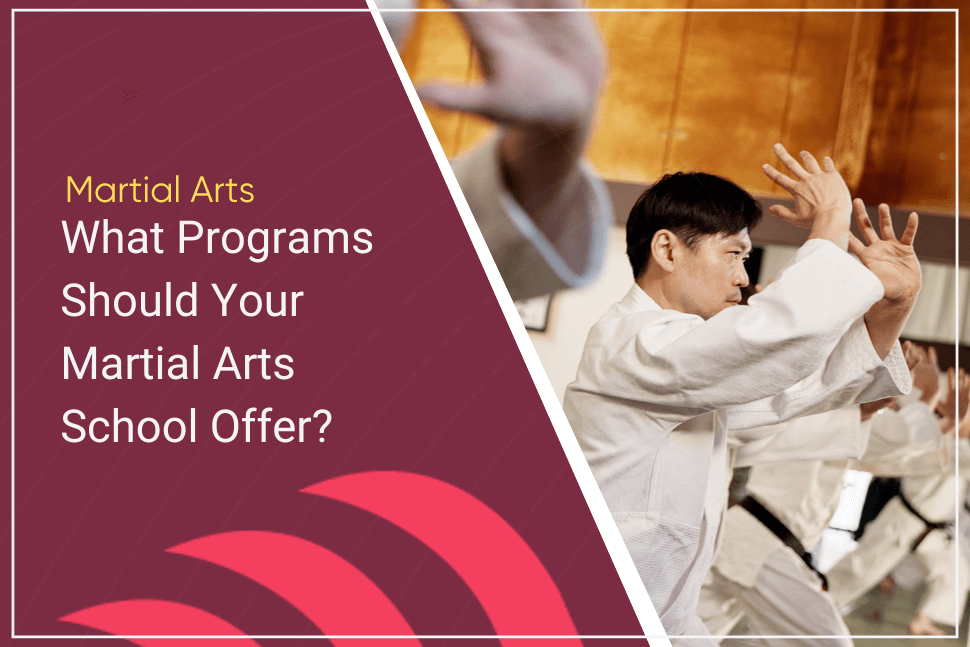Martial Arts Classes to Offer at Your School: A Complete Guide

You're staring at your schedule, trying to figure out which classes will actually fill up.
Add too many, and you're teaching empty rooms. Too few, and you're turning away students who want something different.
The right class mix depends on your community—but most successful martial arts schools balance traditional disciplines (karate, taekwondo, judo) with modern arts (Brazilian Jiu-Jitsu, MMA, Krav Maga), plus supplementary services that increase revenue and keep members engaged longer.
This guide breaks down core classes, revenue-boosting services, and specialized programs that help martial arts schools grow without spreading instructors too thin.
Key Takeaways
- Balance traditional martial arts (karate, taekwondo, judo) with modern disciplines (BJJ, MMA, Krav Maga) to attract diverse student interests while covering both striking and grappling fundamentals
- Add supplementary services like personal training, nutrition coaching, and mindfulness workshops to increase student lifetime value and generate additional revenue streams
- Segment classes by age group (kids, teens, adults, seniors) and experience level (beginner, intermediate, advanced) to maximize engagement and retention
- Family classes and youth programs boost retention significantly because whole-family involvement creates shared goals and longer membership commitments
Core Martial Arts Classes: Traditional vs Modern
Most successful martial arts schools offer at least one traditional art and one modern discipline. This combination gives students variety while covering both striking and grappling foundations.
Traditional martial arts
These established disciplines build fundamental skills and appeal to students seeking structured progression:
Modern martial arts
These popular disciplines attract students interested in real-world application and competitive training:
Why this mix works: Traditional arts provide structured skill progression that appeals to families and younger students. Modern disciplines attract adults seeking practical self-defense and fitness. Students often cross-train between both categories, increasing attendance frequency.
Supplementary Services That Increase Revenue
Supplementary services boost your studio's value proposition while creating additional revenue streams beyond monthly memberships.
Personal training
One-on-one or small-group sessions appeal to students willing to pay premium rates for individualized attention. Personal training students typically see:
- Faster progress: Customized drills target exactly what they need to improve
- Technique correction: Direct feedback fixes bad habits before they become ingrained
- Sustained motivation: Personal accountability keeps students showing up consistently
Pricing typically ranges from $60-$100 per hour depending on your market and instructor credentials.
Nutrition and wellness programs
Martial arts students training for competition or weight management benefit from nutrition guidance. Offer:
- Personalized meal planning aligned with training goals
- Macronutrient advice for weight cutting or muscle gain
- Supplement education for recovery and performance
Partner with a registered dietitian or certified nutritionist to ensure advice meets professional standards.
Wellness workshops
Host monthly or quarterly workshops on topics relevant to martial artists:
- Injury prevention and mobility training
- Sleep optimization for recovery
- Stress management techniques
- Flexibility and stretching protocols
These workshops create community engagement while positioning your school as a holistic training facility rather than just a place to punch and kick.
Mental training and mindfulness
Combat sports require mental toughness alongside physical skills. Include:
- Mindfulness meditation: Improves focus during sparring and reduces pre-competition anxiety
- Breathing exercises: Helps students stay calm under pressure and manage cardio during intense training
- Stress management techniques: Progressive muscle relaxation, guided imagery, and cognitive-behavioral strategies that improve performance
Students who develop mental skills alongside physical techniques typically achieve belt promotions faster and compete more successfully.
Segmenting Classes by Demographics
Beyond your core martial arts offerings, segment classes to serve different age groups, experience levels, and training goals. You won't offer separate classes for every category below—choose based on your community's specific needs and facility capacity.
Age group segmentation
Different age groups seek different benefits from martial arts training:
- Children (ages 4-12): Motor skill development, confidence building, and discipline—keep classes fun and game-based to maintain engagement
- Teens (ages 13-17): Mix traditional arts with modern techniques to match their energy; emphasize competition opportunities and leadership development
- Adults (ages 18-64): Self-defense, fitness, and stress relief; offer flexible scheduling for working professionals
- Seniors (65+): Low-impact training focused on balance, flexibility, and fall prevention; avoid high-intensity sparring
Experience level segmentation
Create clear progression pathways within each age group:
Beginner classes introduce fundamentals in a non-threatening environment. Focus on basic stances, movements, and techniques without intimidating new students with complex combinations.
Intermediate classes build on fundamentals and progressively introduce more advanced techniques like combination strikes, defensive counters, and controlled sparring.
Advanced classes challenge experienced students with rigorous training, complex techniques, and competitive preparation for tournaments.
Interest-based segmentation
Match class offerings to common student goals:
- Self-defense focused: Scenario-based training for real-world situations; popular with women and professionals concerned about personal safety
- Fitness and weight loss: High-intensity classes incorporating cardio and strength training; track measurable fitness metrics to show progress
- Mental and emotional wellness: Emphasize meditation, breathing exercises, and stress reduction alongside physical training; attracts students dealing with anxiety or seeking mindfulness practices
Community and Family-Oriented Programs
Classes that build community increase retention significantly. When students form friendships and families train together, they stick around longer.
Family martial arts classes
Classes where parents and kids train together create multiple benefits:
- Strengthens family bonds through shared goals and activities
- Boosts retention—when the whole family is invested, cancellations drop
- Appeals to busy parents who want family time while staying active
Consider offering family self-defense workshops as trial classes. These 1-2 hour sessions teach basic techniques for common scenarios and work well as intro offers for families hesitant to commit to full memberships.
Youth programs
After-school programs solve a real problem for working parents while filling your daytime hours. Combine:
- Martial arts training (45-60 minutes)
- Homework help and quiet study time
- Structured games and character development activities
You're providing a safe, productive environment—and kids receive physical fitness, discipline, and academic support in one location. This program type often generates higher monthly revenue per student than regular classes alone.
Need marketing ideas? Check out these gym promotion strategies to fill youth program spots quickly.
Summer camps
Intensive martial arts summer camps fill scheduling gaps while attracting new students. Design week-long programs including:
- Daily training sessions (2-3 hours) focused on specific skills
- Martial arts-themed games and team challenges
- Guest instructor demonstrations
- Evening movie nights featuring martial arts films
Summer camps generate significant revenue during a traditionally slow period and convert approximately 30-40% of camp attendees into year-round members when marketed effectively.
Building Your Class Schedule
The right mix of classes helps you serve more of your community without overwhelming your instructors:
- Start with core offerings: 1-2 traditional arts and 1-2 modern disciplines based on instructor expertise
- Add age segmentation: Kids, teens, and adult classes for your most popular styles
- Layer in experience levels: Beginner, intermediate, and advanced tracks as enrollment grows
- Introduce supplementary services: Personal training and workshops once core classes fill consistently
- Test specialized programs: Family classes and youth programs when you have facilities and demand
Once your schedule is built, gym scheduling software automates class bookings, waitlist management, and attendance tracking so you can focus on teaching instead of administrative tasks.
What to Take Away For Building a Profitable Class Schedule
- Offer both traditional (karate, taekwondo, judo) and modern (BJJ, MMA, Krav Maga) martial arts to attract diverse student interests
- Add revenue-generating services like personal training, nutrition programs, and wellness workshops
- Segment classes by age, experience level, and training goals to maximize engagement
- Create family programs and youth offerings that boost retention and generate premium pricing
- Use scheduling software to automate bookings and reduce administrative burden
Martial Arts Class Offerings FAQs
Let’s wrap up with a few final questions and the answers they require.
What is the best martial art for beginners?
Boxing, Muay Thai, and Brazilian Jiu-Jitsu work well for beginners because they build fundamental striking and grappling skills quickly. However, the best martial art for any beginner is one taught by engaging instructors in a welcoming environment—school culture matters more than specific style.
How much do martial arts classes cost on average?
Most martial arts schools charge $150-$250 per month for unlimited group classes. Some schools use tiered pricing (2x/week vs. unlimited), while others add premium pricing for specialized programs. Private lessons typically cost $60-$100 per hour depending on market and instructor credentials.
What are the big 4 martial arts?
The four most popular martial arts are Karate, Taekwondo, Brazilian Jiu-Jitsu, and MMA. These disciplines cover both traditional striking arts and modern grappling systems that form the foundation of most martial arts schools. Together they appeal to diverse student interests while covering comprehensive self-defense skills.
Should I offer both traditional and modern martial arts at my school?
Yes. Offering at least one traditional art (like Karate or Taekwondo) and one modern discipline (like BJJ or MMA) gives students variety while covering both striking and grappling. This mix attracts different student demographics and enables cross-training opportunities that increase attendance frequency and retention.
How many classes should a martial arts school offer per week?
Start with 15-25 classes per week covering your core arts across different age groups and experience levels. Add more classes as enrollment grows and you can maintain minimum attendance thresholds (typically 8-10 students per class for financial viability). Use attendance data to identify which time slots and class types fill consistently before expanding your schedule.
Gym management software that frees up your time and helps you grow.
Simplified billing, enrollment, student management, and marketing features that help you grow your gym or martial arts school.





